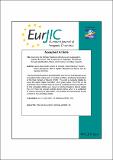Files in this item
Analyzing the relation between structure and aggregation induced emission (AIE) properties of iridium(III) complexes through modification of non-chromophoric ancillary ligands
Item metadata
| dc.contributor.author | Galán, Laura Abad | |
| dc.contributor.author | Cordes, David B. | |
| dc.contributor.author | Slawin, Alexandra M.Z. | |
| dc.contributor.author | Jacquemin, Denis | |
| dc.contributor.author | Ogden, Mark I. | |
| dc.contributor.author | Massi, Massimiliano | |
| dc.contributor.author | Zysman-Colman, Eli | |
| dc.date.accessioned | 2019-11-13T00:36:36Z | |
| dc.date.available | 2019-11-13T00:36:36Z | |
| dc.date.issued | 2018-11-13 | |
| dc.identifier | 256198970 | |
| dc.identifier | bc0b3b73-5987-4a13-a2e1-61d5cd8c2207 | |
| dc.identifier | 85056645662 | |
| dc.identifier | 000456212200002 | |
| dc.identifier.citation | Galán , L A , Cordes , D B , Slawin , A M Z , Jacquemin , D , Ogden , M I , Massi , M & Zysman-Colman , E 2018 , ' Analyzing the relation between structure and aggregation induced emission (AIE) properties of iridium(III) complexes through modification of non-chromophoric ancillary ligands ' , European Journal of Inorganic Chemistry , vol. Early View . https://doi.org/10.1002/ejic.201801118 | en |
| dc.identifier.issn | 1434-1948 | |
| dc.identifier.other | RIS: urn:924352CA493CE6DF239A35FCB91DA42E | |
| dc.identifier.other | ORCID: /0000-0002-5366-9168/work/50743952 | |
| dc.identifier.other | ORCID: /0000-0001-7183-6022/work/56639056 | |
| dc.identifier.other | ORCID: /0000-0002-9527-6418/work/56861418 | |
| dc.identifier.uri | https://hdl.handle.net/10023/18909 | |
| dc.description | E.Z.-C. acknowledges the University of St. Andrews and EPSRC (EP/M02105X/1) for financial support. We thank Umicore AG for the gift of materials. We thank the EPSRC UK National Mass Spectrometry Facility at Swansea University for analytical services. This work is supported by a Royal Society International Exchanges Grant and by the Australian Research Council and. LAG thanks Curtin University for the postgraduate scholarship. This work used the computational resources of the CCIPL installed in Nantes. | en |
| dc.description.abstract | Unconventionally modified dibenzoylmethane (dbm) ligands have been synthesized and successfully utilized as ancillary ligands for neutral Ir(III) complexes of the formula [Ir(dFppy)2(LX)], where dFppyH is 2-(2,4-difluorophenyl)pyridine and LX is tribenzoylmethane ( tbm ) or 1-phenyl-3-(4-(pyridin-2-yl)phenyl)propane-1,3-dione ( pydbm ). The modification of the ligands aims to prevent or enhance possible intermolecular interactions between the dFppy and/or the LX moiety in comparison with the previously reported [Ir(dFppy)2( dbm )] complex. The aggregation induced emission (AIE) properties of these complexes are significantly modulated, as a consequence of the different π-π interactions revealed by X-ray crystallography. | |
| dc.format.extent | 3701754 | |
| dc.language.iso | eng | |
| dc.relation.ispartof | European Journal of Inorganic Chemistry | en |
| dc.subject | Iridium | en |
| dc.subject | Luminescence | en |
| dc.subject | Complexes | en |
| dc.subject | Photophysics | en |
| dc.subject | Optoelectronics | en |
| dc.subject | Ligand effects | en |
| dc.subject | QD Chemistry | en |
| dc.subject | DAS | en |
| dc.subject.lcc | QD | en |
| dc.title | Analyzing the relation between structure and aggregation induced emission (AIE) properties of iridium(III) complexes through modification of non-chromophoric ancillary ligands | en |
| dc.type | Journal article | en |
| dc.contributor.sponsor | EPSRC | en |
| dc.contributor.sponsor | The Royal Society | en |
| dc.contributor.institution | University of St Andrews. School of Chemistry | en |
| dc.contributor.institution | University of St Andrews. EaSTCHEM | en |
| dc.identifier.doi | 10.1002/ejic.201801118 | |
| dc.description.status | Peer reviewed | en |
| dc.date.embargoedUntil | 2019-11-13 | |
| dc.identifier.grantnumber | EP/M02105X/1 | en |
| dc.identifier.grantnumber | IE140044 | en |
This item appears in the following Collection(s)
Items in the St Andrews Research Repository are protected by copyright, with all rights reserved, unless otherwise indicated.

